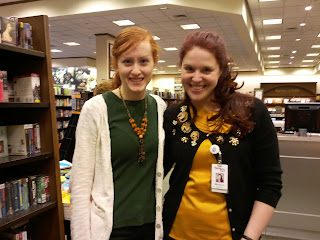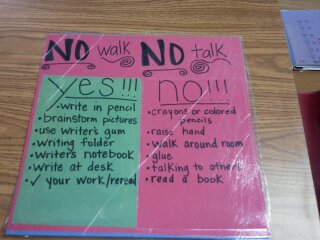Let me introduce my “kid sister teacher”. That is what I feel she is. She is a doll. She has been a participant in many of my trainings and she is just cute as a button. Here is a picture of the two of us… now you know who that girl is with me on Facebook too! My teacher little sister!
Now I will turn it over to The Frizz In First Grade!
****************************************************************************
Hello! Or should I say “Howdy?”
I am the Frizz in First Grade, and I am very excited and honored to be guest blogging from Texas.
Today I want to share with you a great procedure to incorporate into your Writer’s Workshop.
It’s called “No Walk. No Talk.” and it’s simply brilliant.
I cannot take credit for this great idea. I thoughtI had learned it from a Writer’s Institute Training with Melissa, but when she asked me to guest blog about it she also mentioned that it was not from her workshop. Needless to say, this idea is like one of those pinterest ideas that never actually links back to the original source. I will try not to disappoint you in that same way.
Here are the basics of “No Walk. No Talk.”
I teach my long winded half an hour 10 minute mini lesson and send them away from the carpet to do their writing. The first part of writing time is No Walk No Talk.
This is what it looks like for the first 10 or so minutes of writing time: No walking and no talking.
My students know that this time is their 10 minutes of real, authentic WRITING.
With a pencil. Without talking. (And you may not get out of your seat. Or raise your hand to ask me how to spell a word. Or talk to your neighbor about your story. Or get up to get your ninety-ninth tissue of the day even though you don’t have a cold. Or talk to your friend across the room about your birthday party. Or raise your hand to tell me you are wearing new shoes or what kind of birthday party you are having. Or come tap me on the shoulder to ask me if it is time for PE. Or walk around the room. Or talk. PERIOD. End of story.)
Don’t get me wrong. There is a time and a place for all of those things. I am not a crazy-uptight, control-freak teacher (on most days). Because I set clear expectations and procedures, my students are fully engaged in the writing process. By telling my students what they can and cannot do during this time allows the class to settle into writing and actually WRITE. It gets them started quickly and sets boundaries for the workshop.
After the ten minutes is up, I flip the anchor chart to the other side so that the students know No Walk No Talk has ended. This signals a different set of expectations. During this time, students are allowed to whisper read their story to themselves, talk to their writing partner about what they are writing, glue ideas into their Writer’s Notebook, move around the room, and ask me questions (although they usually don’t because they are too busy writing!)
This time usually lasts for 10 minutes depending on our schedule for the day.
Now that you know how the time is structured, let’s get back to setting the expectations of No Walk No Talk with an anchor chart.
Here is the one I use.
The most important thing to remember is to make guidelines based on what you, the teacher, are comfortable with. For example, I noticed that my students were spending a LARGE portion of their writing time coloring their pictures. This is an important part of the writing process, but I felt like it was getting in the way of their writing. So I decided to ban crayons during No Walk No Talk.
I also noticed that students were spending way too much time gluing ideas into their Writer’s Notebooks instead of actually writing. Again, I told them “No Glue.”
Before you get caught up in what you DON’T want them to do during this time, think about what you DOwant them to accomplish. I wanted my students spend a large amount of time writing words with their pencils because I know they need lots of exposure to the writing process.
I wanted them to be able to draw a quick picture to help them brainstorm their story parts.
I knew they would need to use their Writer’s Gum and their Writer’s notebook when they got stuck. Those were the things I focused on. Those were the things I made sure to model a LOT of before I introduced No Walk No Talk.
Practice makes perfect better than the next day. Get out there and try it! You will be surprised at how quickly your students become comfortable with writing.
Special thanks to Melissa for letting me guest blog.




Love this guest post! I love the "share chair" and "writer's gum" and "no walk, no talk." I have a lot of things to mull around in my head now and get ready to incorporate into my teaching! Thanks!
Covered in Glitter and Glue
Let me (or better yet Melissa-she's the expert!) know if you have any questions along the way.
I'd love to help a girl out and pay it forward 🙂
The Frizz